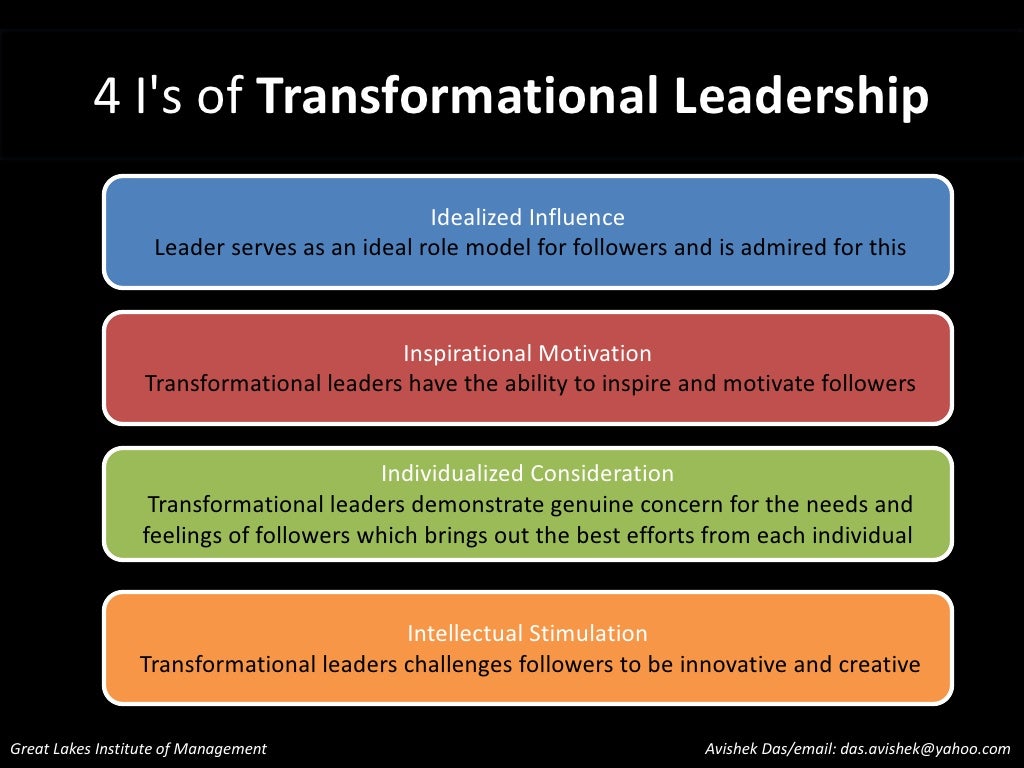Transformational leaders typically perform four distinct behaviors, also known as the four i's. Transformational leaders not only challenge the status quo;

Transformational Leadership The Secret to Organizational Success
Transformational leadership has a long history and it evolved after earlier theories on behavioral, trait, charismatic & situational leadership models.

The four i's of transformational leadership. The term was first coined by james downton in the early 1970s, and the work was expanded several times: Four i's of transformational leadership. The four i's of leadership are four unique leadership talents, each beginning with the letter i:
Authenticity, coaching insight and innovation. As the name implies, transformational leadership is a different way of thinking about leading and managing teams. The top goal of a transformational leader is to get the full support of everyone involved, all with an eye for the common goal.
Bass, who expanded on burns’ idea. Serving as a role model and demonstrating established organizational values. They recognize followers through stimulation, creativity and innovation.
Transformational leaders do four things that help others develop as leaders. These can be connected back to the 4 i’s: An authentic leader serves as a role model to inspire moral and fair behavior, as well as to command esteem and confidence from colleagues.
There are four (4) main characteristics of transformational leadership, and these can be summarized as: Develop a challenging and attractive vision, together with the employees. It is at the core of effective leadership.
Develop the vision, specify and translate it to actions. Transformational leadership is based on four i's characteristics, as shown in figure 1. Here are the four typical traits of a transformational leader:
Combine this with idealized influence, and this is. Especially, charisma is one of the components of transformational leadership. Transformational leadership also involves offering support and encouragement to individual.
True leaders need much more than that to succeed, particularly as more and more employees demand greater clarity on their roles and more influence over how their contribution will help a company to thrive. The 4 leadership competencies required of most leaders are: Yukl (1994) draws some tips for transformational leadership:
So, it has overlapping with those other theories. The second element is inspirational motivation. There are four basic components to transformational leadership, according to researcher bernard m.
Individual influence transformational leaders are capable of transmitting a message to each person in their team. They arrive early and stay late. Passionately communicating an exciting vision of the future while also encouraging followers to keep pursuing the overall objective.
There are four components of transformational leadership[1]. The leader encourages followers to explore new ways of doing things and new opportunities to learn. (bass, 1985(bass, , 1990(bass, , 1995(bass, , 2008 researchers have.
They also encourage creativity among followers. The four i's of leadership. Understanding the basics of transformational leadership and the four i's can help a manager apply this approach.
The best way to do this is to be open and honest about challenges. These leaders are not afraid to get their hands dirty and show others how to do the job and do it well. Leaders act as mentors, or a coach and are willing and open to listening to their followers’ concerns.
These behaviors are inspirational motivation, idealized influence, intellectual. Transformational leaders have the ability to inspire and motivate followers. Intellectual stimulation is the extent to which transformational leaders challenge assumptions, take risks and solicit followers’ ideas.
In effect a leader can grow their charisma by utilizing their resources effectively. The four i’s of transformational leaders. Becoming an effective transformational leader is an iterative process.
According to northouse (2001), a transformational leader has the following qualities: Express confidence, decisiveness and optimism about the. Transformational leadership is about much more than simply dictating the role of a ‘boss’ in a formal setting.
This means that conscious effort must be made to adopt a transformational style. The four i’s of transformational leadership consist of: Leads by example (idealized influence, or ii).
The characteristics which differentiate transactional from transformational leadership are discussed, highlighting the differences between managers and leaders. Tie the vision to a strategy for its achievement.

MyLEAD360 Lessons on Leadership and Followership Your Roadmap to

The four leadership principles for the 4IR Download Scientific Diagram

Inspire others through transformational leadership American Nurse

Characteristics of Transformational Leadership in Remote Organizations

Leadership styles Four common types in business MasterStart